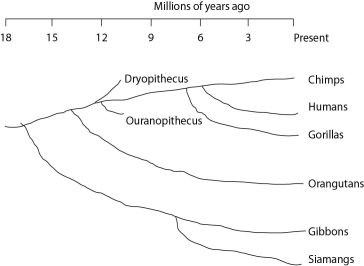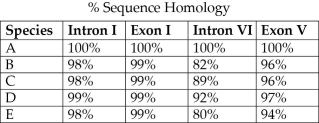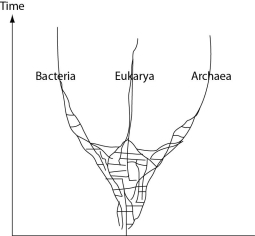A) frogs evolved before mice.
B) mice evolved before frogs.
C) the genes of frogs and mice have only coincidental homoplasies.
D) the homolog has evolved more slowly in mice.
E) the homolog has evolved more rapidly in mice.
Correct Answer

verified
Correct Answer
verified
Multiple Choice
The various taxonomic levels (namely, genera, classes, etc.) of the hierarchical classification system differ from each other on the basis of
A) how widely the organisms assigned to each are distributed throughout the environment.
B) their inclusiveness.
C) the relative genome sizes of the organisms assigned to each.
D) morphological characters that are applicable to all organisms.
Correct Answer

verified
Correct Answer
verified
Multiple Choice
Some molecular data place the giant panda in the bear family (Ursidae) but place the lesser panda in the raccoon family (Procyonidae) . Consequently, the morphological similarities of these two species are probably due to
A) inheritance of acquired characteristics.
B) sexual selection.
C) inheritance of shared derived characters.
D) possession of analogous structures.
E) possession of shared primitive characters.
Correct Answer

verified
Correct Answer
verified
Multiple Choice
Which of the following is true of all horizontally oriented phylogenetic trees, where time advances to the right?
A) Each branch point represents a point in absolute time.
B) Organisms represented at the base of such trees are descendants of those represented at higher levels.
C) The fewer branch points that occur between two taxa, the more divergent their DNA sequences should be.
D) The common ancestor represented by the rightmost branch point existed more recently in time than the common ancestors represented at branch points located to the left.
E) The more branch points there are, the fewer taxa are likely to be represented.
Correct Answer

verified
Correct Answer
verified
Multiple Choice
Placing whales and hippos in the same clade means that
A) these organisms are phenotypically more similar to each other than to any others shown on the trees in Figure 20.2.
B) their morphological similarities are probably homoplasies.
C) they had a common ancestor.
D) all three of the responses are correct.
E) two of the responses are correct.
Correct Answer

verified
Correct Answer
verified
Multiple Choice
 Figure 20.4 Humans, chimpanzees, gorillas, and orangutans are members of a clade called the great apes, which shared a common ancestor about 18 million years ago. Gibbons and siamangs comprise a clade called the lesser apes. Tree-branch lengths indicate elapsed time.
-From Figure 20.4, which other event occurred closest in time to the divergence of gorillas from the lineage that led to humans and chimps?
Figure 20.4 Humans, chimpanzees, gorillas, and orangutans are members of a clade called the great apes, which shared a common ancestor about 18 million years ago. Gibbons and siamangs comprise a clade called the lesser apes. Tree-branch lengths indicate elapsed time.
-From Figure 20.4, which other event occurred closest in time to the divergence of gorillas from the lineage that led to humans and chimps?
A) the divergence of chimps and humans
B) the divergence of Dryopithecus and Ouranopithecus
C) the divergence of gibbons and siamangs
D) could be either the divergence of chimps and humans OR of Dryopithecus and Ouranopithecus
E) could be either the divergence of chimps and humans OR of gibbons and siamangs
Correct Answer

verified
Correct Answer
verified
Multiple Choice
The next questions refer to Table 20.1, which compares the % sequence homology of four different parts (two introns and two exons) of a gene that is found in five different eukaryotic species. Each part is numbered to indicate its distance from the promoter (e.g., Intron I is the one closest to the promoter) . The data reported for species A were obtained by comparing DNA from one member of species A to the DNA of another member of species A.
 Table 20.1
-Regarding these sequence homology data, the principle of maximum parsimony would be applicable in
Table 20.1
-Regarding these sequence homology data, the principle of maximum parsimony would be applicable in
A) distinguishing introns from exons.
B) determining degree of sequence homology.
C) selecting appropriate genes for comparison among species.
D) inferring evolutionary relatedness from the number of sequence differences.
Correct Answer

verified
Correct Answer
verified
Multiple Choice
It was once thought that cetaceans had evolved from an extinct group of mammals called the mesonychids. If, in the future, it is determined that some organisms currently classified as cetaceans did actually evolve from mesonychids, whereas other cetaceans evolved from artiodactyl stock, then what will be true of the order Cetacea?
A) It will be paraphyletic.
B) It will be polyphyletic.
C) It will need to be modified if classification is to reflect evolutionary history.
D) A and C
E) B and C
Correct Answer

verified
Correct Answer
verified
Multiple Choice
Which kind of DNA should provide the best molecular clock for determining the evolutionary relatedness of several species whose common ancestor became extinct billions of years ago?
A) that coding for ribosomal RNA
B) intronic DNA belonging to a gene whose product performs a crucial function
C) paralogous DNA that has lost its function (i.e., no longer codes for functional gene product)
D) mitochondrial DNA
E) exonic DNA that codes for a noncrucial part of a polypeptide
Correct Answer

verified
Correct Answer
verified
Multiple Choice
The term homoplasy is most applicable to which of the following features?
A) the legless condition found in various lineages of extant lizards
B) the five-digit condition of human hands and bat wings
C) the β hemoglobin genes of mice and of humans
D) the fur that covers Australian moles and North American moles
E) the bones of bat forelimbs and the bones of bird forelimbs
Correct Answer

verified
Correct Answer
verified
Multiple Choice
In a comparison of birds and mammals, the condition of having four limbs is
A) a shared ancestral character.
B) a shared derived character.
C) a character useful for distinguishing birds from mammals.
D) an example of analogy rather than homology.
E) a character useful for sorting bird species.
Correct Answer

verified
Correct Answer
verified
Multiple Choice
The following questions refer to the phylogenetic tree in Figure 20.3, depicting the origins of life and of the three domains. Horizontal lines indicate instances of gene or genome transfer.
 Figure 20.3
A possible phylogenetic tree for the three domains of life.
-Which of these processes can be included among those responsible for the horizontal components of Figure 20.3?
Figure 20.3
A possible phylogenetic tree for the three domains of life.
-Which of these processes can be included among those responsible for the horizontal components of Figure 20.3?
A) endosymbiosis
B) mitosis
C) binary fission
D) point mutations
E) S phase of the cell cycle
Correct Answer

verified
Correct Answer
verified
Multiple Choice
Which of these would, if it had acted upon a gene, prevent this gene from acting as a reliable molecular clock?
A) neutral mutations
B) genetic drift
C) mutations within introns
D) natural selection
E) most substitution mutations involving an exonic codon's third position
Correct Answer

verified
Correct Answer
verified
Showing 41 - 53 of 53
Related Exams